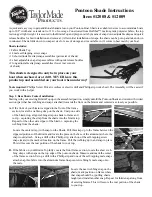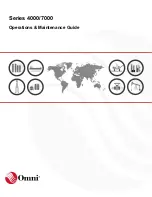
3
L44_PROGRESS_L445000D (211212)
(EN) ENGLISH
Only the techniques shown in the diagrams that are not crossed out and/or do
not display a skull and crossbones symbol are authorized. Check our Web site
www.petzl.com regularly to find the latest versions of these documents and/or
supplementary information.
Contact PETZL if you have any doubt or difficulty understanding these documents.
Asymmetrical Y-lanyard
1. Field of application
Personal protective equipment (PPE). Progression lanyard. This product is certified
to EN 354: 2010.
Asymmetrical dynamic rope lanyard for attachment to a rope clamp, a lifeline, or
for passing intermediate anchors.
Do not use it for via ferrata or for any other similar situation.
This product must not be loaded beyond its strength rating, nor be used for any
purpose other than that for which it is designed.
WARNING
Activities involving the use of this equipment are inherently dangerous.
You are responsible for your own actions and decisions.
Before using this equipment, you must:
- Read and understand all instructions for use.
- Get specific training in its proper use.
- Become acquainted with its capabilities and limitations.
- Understand and accept the risks involved.
Failure to heed any of these warnings may result in severe injury or death.
Responsibility
WARNING, specific training in the activities defined in the field of application is
essential before use. This training must be adapted to the practices defined under
the Field of Application.
This product must only be used by competent and responsible persons, or those
placed under the direct and visual control of a competent and responsible person.
Gaining an adequate apprenticeship in appropriate techniques and methods of
protection is your own responsibility.
You personally assume all risks and responsibilities for all damage, injury or death
which may occur during or following incorrect use of our products in any manner
whatsoever. If you are not able, or not in a position to assume this responsibility or
to take this risk, do not use this equipment.
2. Nomenclature of parts
(1) Short arm, (2) Long arm, (3) Sewn termination with plastic protection,
(4) Carabiner attachment hole, (5) Harness attachment hole, (6) Fall indicator.
Lanyard made of nylon rope
3. Inspection, points to verify
Before each use
Check the rope and the safety stitching. Look for cuts in the webbing, wear and
damage due to use, to heat, and to contact with chemical products, etc...
Be particularly careful to check for cut/distended threads.
Verify that the fall indicator is present.
During each use
Make sure that all pieces of equipment in the system are correctly positioned with
respect to each other.
It is important to regularly monitor the condition of the product and its connections
to the other equipment in the system.
Consult the details of the inspection procedure to be carried out for each item of
PPE on the Web at www.petzl.com/ppe
4. Compatibility
For all of your applications, verify the compatibility of this product with the other
elements of your system (compatibility = good functional interaction).
5. Preparation
- Put a locking carabiner into each attachment hole.
- Put a quick link (EN 362 class Q) or an OMNI locking carabiner in the lanyard’s
harness attachment hole. Attach this connector to the harness attachment point.
Lock the connector
WARNING: If this lanyard is used with an energy absorber, the total length of the
assembly (energy absorber, lanyard, and connectors) must not exceed two meters.
If used with an energy absorber, do not attach the lanyard’s unused arm to the
harness: in this case, the absorber will not work.
6. Fall indicator
The fall indicator disappears when the lanyard has been subjected to a major fall
(6 kN).
When the fall indicator has disappeared, retire your lanyard as soon as possible.
7. Uses
A lanyard must not be used as part of a fall arrest system without an energy
absorber. In the case of this lanyard, the rope acts as an energy absorber for fall
factors less than one. Falls of factor one or more are prohibited.
Horizontal progression
7A. When moving, always use two lanyard ends.
7B. Passing an intermediate anchor (see drawings).
Precautions
- A wet or icy rope is weaker and less abrasion resistant.
- Before beginning work, if you think there is a risk of the lanyard contacting a
sharp edge, be sure to take appropriate precautions.
- In case of a fall risk, limit slack in the lanyard as much as possible.
- Avoid areas where there is a fall risk.
- This lanyard is not designed for making girth hitches.
Vertical progression
The lanyard can be used to attach yourself to a rope clamp, for example an
ASCENSION.
When passing an intermediate anchor, use the short arm of the lanyard to attach
yourself to the anchor and pass it.
Do not climb above the rope clamp/grab or the anchor point and keep your lanyard
under tension.
Shock loading must be avoided when close to the anchor.
9. Supplementary information regarding
standards (EN 365)
Rescue plan
You must have a rescue plan and the means to rapidly implement it in case of
difficulties encountered while using this equipment.
Anchors
The anchor point for the system should preferably be located above the user’s
position and should meet the requirements of the EN 795 standard (minimum
strength of 10 kN).
Various
- In a fall-arrest system, it is essential to check the required clearance under the
user before each use, to avoid any impact with the ground or an obstacle in case
of a fall.
- Make sure that the anchor point is correctly positioned, in order to limit the risk
and the height of a fall.
- A fall arrest harness is the only device allowable for supporting the body in a fall
arrest system.
- When using multiple pieces of equipment together, a dangerous situation can
result if the safety function of one piece of equipment is affected by the safety
function of another piece of equipment.
- WARNING DANGER, take care that your products do not rub against abrasive or
sharp surfaces.
- Users must be medically fit for activities at height. WARNING, inert suspension in
a harness can result in serious injury or death.
- The instructions for use for each item of equipment used in conjunction with this
product must be respected.
- The instructions for use must be provided to users of this equipment in the
language of the country in which the product is to be used.
10. Petzl general information
Lifetime / When to retire your equipment
For Petzl’s plastic and textile products, the maximum lifetime is 10 years from the
date of manufacture. It is indefinite for metallic products.
ATTENTION: an exceptional event can lead you to retire a product after only one
use, depending on the type and intensity of usage and the environment of usage
(harsh environments, marine environment, sharp edges, extreme temperatures,
chemical products, etc.).
A product must be retired when:
- It is over 10 years old and made of plastic or textiles.
- It has been subjected to a major fall (or load).
- It fails to pass inspection. You have any doubt as to its reliability.
- You do not know its full usage history.
- When it becomes obsolete due to changes in legislation, standards, technique or
incompatibility with other equipment, etc.
Destroy retired equipment to prevent further use.
Product inspection
In addition to the inspection before each use, an in-depth inspection must be
carried out by a competent inspector. The frequency of the in-depth inspection
must be governed by applicable legislation, and the type and the intensity of use.
Petzl recommends an inspection at least once every 12 months.
To help maintain product traceability, do not remove any markings or labels.
Inspection results should be recorded on a form with the following details: type of
equipment, model, manufacturer contact information, serial number or individual
number, date of manufacture, date of purchase, date of first use, date of next
periodic inspection, problems, comments, the name and signature of the inspector.
See an example at www.petzl.com/ppe
Storage, transport
Store the product in a dry place away from exposure to UV, chemicals, extreme
temperatures, etc. Clean and dry the product if necessary.
Modifications, repairs
Modifications and repairs outside of Petzl facilities are prohibited (except
replacement parts).
3-year guarantee
Against all material or manufacturing defect. Exclusions: normal wear and tear,
oxidation, modifications or alterations, incorrect storage, poor maintenance,
negligence, uses for which this product is not designed.
Responsibility
Petzl is not responsible for the consequences, direct, indirect or accidental, or any
other type of damage befalling or resulting from the use of its products.
Traceability and markings
a. Body controlling the manufacture of this PPE
b. Notified body that carried out the CE type inspection
c. Traceability: datamatrix = product ref individual number
d. Diameter
e. Individual number
f. Year of manufacture
g. Day of manufacture
h. Control or name of inspector
i. Incrementation
j. Standards




































